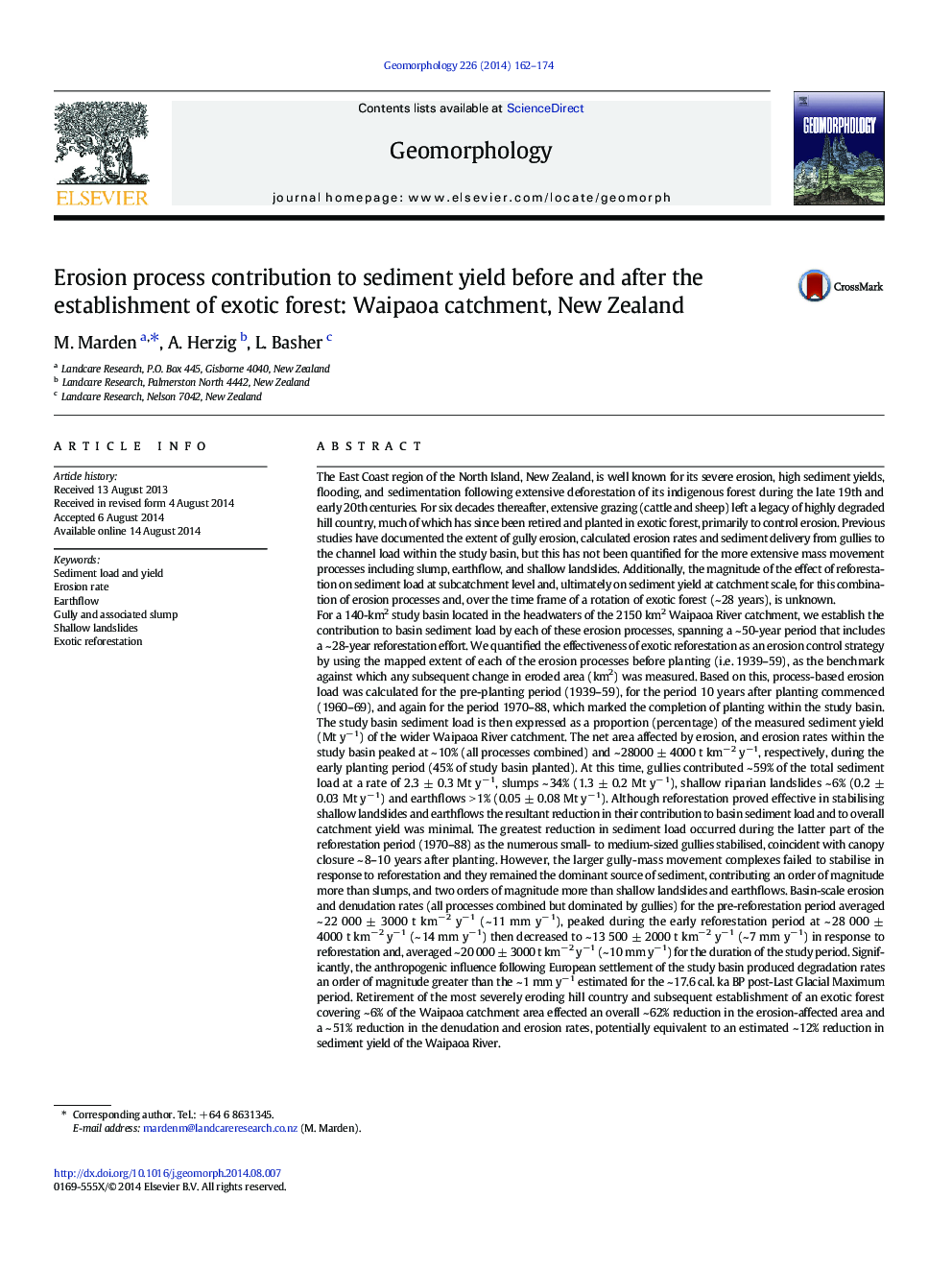| کد مقاله | کد نشریه | سال انتشار | مقاله انگلیسی | نسخه تمام متن |
|---|---|---|---|---|
| 4684448 | 1635423 | 2014 | 13 صفحه PDF | دانلود رایگان |
• Erosion rates are calculated before, during and after reforestation.
• Gullies and associated slumping dominate the sediment supply.
• Intermittent earthflow and shallow landslides contribute the least sediment.
• Reforestation reduced erosion by 51% and sediment yield by 12%.
The East Coast region of the North Island, New Zealand, is well known for its severe erosion, high sediment yields, flooding, and sedimentation following extensive deforestation of its indigenous forest during the late 19th and early 20th centuries. For six decades thereafter, extensive grazing (cattle and sheep) left a legacy of highly degraded hill country, much of which has since been retired and planted in exotic forest, primarily to control erosion. Previous studies have documented the extent of gully erosion, calculated erosion rates and sediment delivery from gullies to the channel load within the study basin, but this has not been quantified for the more extensive mass movement processes including slump, earthflow, and shallow landslides. Additionally, the magnitude of the effect of reforestation on sediment load at subcatchment level and, ultimately on sediment yield at catchment scale, for this combination of erosion processes and, over the time frame of a rotation of exotic forest (~ 28 years), is unknown.For a 140-km2 study basin located in the headwaters of the 2150 km2 Waipaoa River catchment, we establish the contribution to basin sediment load by each of these erosion processes, spanning a ~ 50-year period that includes a ~ 28-year reforestation effort. We quantified the effectiveness of exotic reforestation as an erosion control strategy by using the mapped extent of each of the erosion processes before planting (i.e. 1939–59), as the benchmark against which any subsequent change in eroded area (km2) was measured. Based on this, process-based erosion load was calculated for the pre-planting period (1939–59), for the period 10 years after planting commenced (1960–69), and again for the period 1970–88, which marked the completion of planting within the study basin. The study basin sediment load is then expressed as a proportion (percentage) of the measured sediment yield (Mt y− 1) of the wider Waipaoa River catchment. The net area affected by erosion, and erosion rates within the study basin peaked at ~ 10% (all processes combined) and ~ 28000 ± 4000 t km− 2 y− 1, respectively, during the early planting period (45% of study basin planted). At this time, gullies contributed ~ 59% of the total sediment load at a rate of 2.3 ± 0.3 Mt y− 1, slumps ~ 34% (1.3 ± 0.2 Mt y− 1), shallow riparian landslides ~ 6% (0.2 ± 0.03 Mt y− 1) and earthflows > 1% (0.05 ± 0.08 Mt y− 1). Although reforestation proved effective in stabilising shallow landslides and earthflows the resultant reduction in their contribution to basin sediment load and to overall catchment yield was minimal. The greatest reduction in sediment load occurred during the latter part of the reforestation period (1970–88) as the numerous small- to medium-sized gullies stabilised, coincident with canopy closure ~ 8–10 years after planting. However, the larger gully-mass movement complexes failed to stabilise in response to reforestation and they remained the dominant source of sediment, contributing an order of magnitude more than slumps, and two orders of magnitude more than shallow landslides and earthflows. Basin-scale erosion and denudation rates (all processes combined but dominated by gullies) for the pre-reforestation period averaged ~ 22 000 ± 3000 t km− 2 y− 1 (~ 11 mm y− 1), peaked during the early reforestation period at ~ 28 000 ± 4000 t km− 2 y− 1 (~ 14 mm y− 1) then decreased to ~ 13 500 ± 2000 t km− 2 y− 1 (~ 7 mm y− 1) in response to reforestation and, averaged ~ 20 000 ± 3000 t km− 2 y− 1 (~ 10 mm y− 1) for the duration of the study period. Significantly, the anthropogenic influence following European settlement of the study basin produced degradation rates an order of magnitude greater than the ~ 1 mm y− 1 estimated for the ~ 17.6 cal. ka BP post-Last Glacial Maximum period. Retirement of the most severely eroding hill country and subsequent establishment of an exotic forest covering ~ 6% of the Waipaoa catchment area effected an overall ~ 62% reduction in the erosion-affected area and a ~ 51% reduction in the denudation and erosion rates, potentially equivalent to an estimated ~ 12% reduction in sediment yield of the Waipaoa River.We conclude that a greater or similar level of success could be achieved within three decades of forest establishment elsewhere in the East Coast region by specifically targeting gully-mass movement complexes—particularly in high sediment-yielding river systems such as the Waiapu Catchment.
Journal: Geomorphology - Volume 226, 1 December 2014, Pages 162–174
